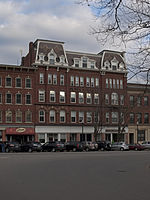Dinsmoor–Hale House
Buildings and structures in Keene, New HampshireHouses completed in 1860Houses in Cheshire County, New HampshireHouses on the National Register of Historic Places in New HampshireItalianate architecture in New Hampshire ... and 2 more
Keene State CollegeNational Register of Historic Places in Cheshire County, New Hampshire

The Dinsmoor–Hale House is a historic house at the southwest corner of Main and Winchester Streets in Keene, New Hampshire. It was built in 1860 for Samuel Dinsmoor, Jr., a lawyer and former Governor of New Hampshire, and was later owned by Governor Samuel W. Hale, who made lavish alterations to its interior. It was acquired by what is now Keene State College in 1909. It now houses the office of the college president. The house was listed on the National Register of Historic Places in 1976.
Excerpt from the Wikipedia article Dinsmoor–Hale House (License: CC BY-SA 3.0, Authors, Images).Dinsmoor–Hale House
Main Street, Keene
Geographical coordinates (GPS) Address Website Nearby Places Show on map
Geographical coordinates (GPS)
| Latitude | Longitude |
|---|---|
| N 42.9275 ° | E -72.277777777778 ° |
Address
Keene State College
Main Street 229
03431 Keene
New Hampshire, United States
Open on Google Maps










